I often get asked to recommend Xeriscape plants for Colorado landscapes. This is a difficult task because there are so many to chose from, and I would hate to limit anyone’s pallette to a limited number. After all, it is the variety in color, textures, and form that makes Xeriscaping so attractive.
That being said, I do think a small list can be helpful to people who are new to the area, or are not familiar with the available plant choices and may be overwhelmed by a catalog of thousands of plants. Although this is a Colorado list, most of these plants can be used in many places throughout the world depending on the local climate.
- Fernbush – Chamaebatiaria millefolium Fernbush is a medium sized shrub with interesting fern-like leaves that persist throughout the winter. This shrub requires little water or maintenance, and produces clusters of small white flowers in the late spring through early summer.
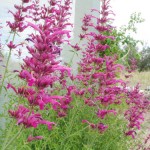
- Agastache – Agastache ssp. Agastache, or hummingbird mint, is a fragrant group of colorful perennial herbs that is available in many colors mostly ranging from orange to pink. The plants are covered with beautiful tubular flowers from mid-summer to fall. Hummingbirds absolutely love these plants.
- Panchito Manzanita – Arctostaphylos x coloradoensis ‘Panchito’ Panchito Manzanita is a low growing woody shrub with shiny, oval, dark green leaves that persist throughout the winter. It gets small, pale pink flowers followed by small red berries- but it’s best characteristics are the evergreen foliage and the fact that it requires little care or water. For more info read my previous post dedicated to this plant.
- Yarrow – Achillea ssp. Yarrow is a group of Rocky Mountain native perennials that are available in many colors, ranging from yellow, to white, to red. The plants are very drought tolerant, requiring almost no watering once established. Fern-like, finely dissected leaves form clumps at the base of the plant, often naturalizing and spreading. Flowers are produced on stiff, tall stalks throughout the summer.
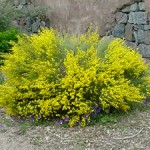
- Spanish Gold Broom – Cytisus purgans ‘Spanish Gold’ Spanish Gold Broom is a medium sized deciduous shrub that is native to the Mediterranean. In late spring it is covered with small yellow pea-like blossoms. This shrub grows in a mounding, cascading form of bright green stems that remain green throughout the winter. The small leaves drop by mid-summer.
- Catmint – Nepeta ssp. Catmint is a widely used mint that produces an abundance of blue flowers. The reasons that I like this plant are first, that it is one of the earlier Xeriscape perennials to emerge in the spring to form an attractive clump of blue-green foliage, and second, that it flowers all summer long and requires zero maintenance.
- Iceplant – Delosperma ssp. The Iceplant that we use in Colorado is a perennial that is native to the higher elevations of South Africa. Note that this is not the invasive Iceplant that is a problem in Southern California. Delospermas form a ground-hugging mat of succulent leaves that range from grey to green. The plants are coated with shiny, delicate flowers in colors from red, to purple, to pink, often with different colored centers. One of my favorite plants.
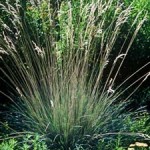
- Blue Avena Grass – Helictotrichon sempervirens Blue Avena Grass is a striking addition to any landscape. Large clumps of blue-gray leaves give this grass a unique texture and contrast among other plants. In mid-summer a large group of tan seedheads gracefully arch from the plant and stand out from the blue foliage. Like most grasses, Blue Avena requires little maintenance or supplemental watering.
- Penstemon – Penstemon ssp. Penstemon is another group of Rocky Mountain native perennials that requires little watering once established, preferring well drained soils. Penstemons are available in just about every color. These plants are small in size which makes them ideal for filling in between other Xeriscape plants. They provide an abundance of colorful blooms that attract butterflies and hummingbirds.
- Mojave Sage – Salvia pachyphylla Mojave Sage is a large shrubby perennial that produces an abundance of striking purplish-blue flowers throughout the summer. The silver-green foliage really stands out too, growing up to 3 feet tall, and persisting as a semi-evergreen throughout the winter.
- Prairie Winecups – Callirhoe involucrata Prairie Winecups is a Colorado native perennial that grows in a low mound of trailing stems covered in round dark-green leaves. The plant produces a large number of cup shaped wine-red colored flowers from late spring through summer. Because this is a native plant it is well adapted to our local climate and requires little maintenance.
- Mexican Feather Grass – Nassella tenuissima Mexican Feather Grass has a fine, hair-like form that gives this grass a texture like none other. Early in the summer the fine tufts of grass are bright green, then they fade to a striking golden yellow in the mid summer through the fall and winter. The way that this grass moves in the breeze brings a graceful movement to the landscape.
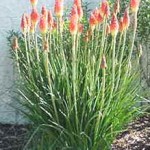
- Torch Lilly – Kniphofia ssp. Torch Lillies are interesting because of their unique foliage and flowers. The foliage is grass-like, and grows in thick clumps ranging in color from blue-green to dark green. The flowers are produced in a tight bunch on tall spikes, and the flowers open from the bottom of the spike upwards.
- Crimson Pygmy Barberry – Berberis thunbergii ‘Crimson Pygmy’ Crimson Pygmy Barberry is a compact deciduous shrub with small red leaves and stems. The red color makes an excellent contrast with the tan and blue hues of the late summer Xeriscape. This shrub is easy to care for, and maintains a very compact and dense form.
- Agave – Agave ssp. Agave is native to the Southwestern United States and Mexico, and it thrives in hot, dry locations. Most of the Agave’s have beautiful thick blue foliagewith spines on the tips of the leaves. A very low maintenance plant for dry southern and western exposures.
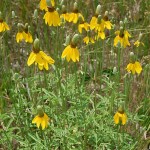
- Prairie Coneflower – Ratibida ssp. Prairie Coneflower is a tall, vigorously growing perennial that requires little maintenance and produces flowers throughout the summer. The foliage is bright green, and available flower colors include yellow with dark brown centers, and burgundy red with dark brown centers. The seeds are easy to harvest and sow the following spring.
- Creeping Western Sand Cherry – Prunus besseyi ‘Pawnee Buttes’ Creeping Western Sand Cherry is the low growing form of Western Sand Cherry that is native to the Rocky Mountains. The plant has bright green leaves, and produces fragrant white flowers in the spring, followed by small black fruit that attract birds and wildlife. In the fall, the leaves turn to beautiful shades of burgundy and red.
- Coral Bells – Heuchera ssp. Coral Bells are a widely used favorite because they are easy to grow and care for. The large leaves are available in a variety of hues from light green, to burgundy, to silvery green. Coral Bells does very well in shade to partial sun. Available flower colors range from white to red, and are produced on slender stalks in late spring to early summer.
- Yucca – Yucca ssp. Yuccas are native to the Southwestern United States and Mexico. There are many different varieties to choose from with various forms of stiff sword-like leaves ranging from dark green to blue-green. Yuccas are a true evergreen that brings form and structure to the landscape year-round. Most Yuccas produce large showy spikes of white bell shaped flowers in mid summer.
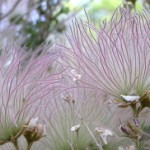
- Apache Plume – Fallugia paradoxa Apache Plume is large native deciduous shrub with whitish stems and branches covered with small light green leaves. Some of the leaves persist throughout the winter. The shrub produces single white flowers in mid summer, followed by the very unique and attractive rose and pink colored plumes that give this plant it’s name. A very unique and versatile shrub that grows vigorously in it’s native habitat of Colorado.
The Criteria for this List:
– This list is for the Front Range of Colorado. We are somewhere in the middle of zone 4 to 5 on the USDA Plant Hardiness Zone Map. I will plan to follow up with a separate post for the mountain areas located above about 7,000 feet in elevation.
– I have only included plants that are very easy to care for, and have excluded plants that require a lot of water since that is a key component of Xeriscape. The “best” plants, in my opinion, are those that are well adapted to the local climate and do not require much additional water and maintenance. Of course there are occasions where the use of higher water-use plants is desirable, such as in drainage areas, however I have left them off of this particular list. And if this were a list of my personal “favorite” plants then I would probably include some that require a little extra care.
– I am not a botanist- I am a landscape architect. This means that I am far from an expert on the science and anatomy of plants. Instead, I am influenced by characteristics such as: how the plant works in an overall design, its adaptability to a variety of sites, the colors and form of the foliage, the availability and cost of the plants, etc.
– This list includes a good mixture of evergreen and deciduous shrubs, perennials, and ornamental grasses that will provide a variety of color, texture, and interest throughout each of the seasons. I have excluded trees, bulbs, and annuals for the purpose of this list. There are so many of each to chose from that I will provide future lists for each category.
This is the official blog of Outdoor Design Group, Colorado Landscape Architects. For more information about our business and our services, click here.
This is a insane post. I’m really happy to have found this! I cannot wait to let my family know about this.
Thanks, great information!
Great info! Do you have the list for above 7000′ available? Please send to me. Thanks much.
Jim,
Glad you like it! I am working on putting a list together for above 7,000 feet, please stay tuned… There are definitely some different issues and challenges that come with the higher elevation.
Ok did I actually see you can grow agave plants in Colorado? Is there a specific species? I am looking fo one that can withstand our Colorado cooler weather. I would like to create a succulent space garden in my back yard
Yes, there are a few species of Agaves that can grow in some areas of Colorado (depending on the USDA Hardiness zone of those areas). One great resource for cold hardy Agaves is the website Cold Hardy Cactus: http://www.coldhardycactus.com. Kelly Grummons is the owner/operator of the website and he has a great wealth of knowledge and experience growing various Agaves, Cacti and Yuccas as well as many other plants. His page that specifically lists Agaves is: http://www.coldhardycactus.com/collections/agave
I think the species I have seen growing at the Denver Botanic Gardens are Agave havardiana and Agave parryi. There may be others in their collection as well. Happy Gardening!
The high altitude plan list is done! See it here: http://www.lot-lines.com/the-best-plants-for-high-altitude-landscaping
If you like this article, check out my new post on the “10 Best Evergreen Xeriscape Plants for Colorado”: http://www.lot-lines.com/the-10-best-evergreen-xeriscape-plants-for-colorado
perfect i am landscaping a 7,000 foot high moutain cabin need all the help i can get im a city gal and totally clueless your webite is perfect appeciate any other xerscaping perennials in front of a log cabin thxs have a margarita day thxs
This is wonderful. I’m on the Western Slope, in Carbondale. I’m busy tearing out the lawn of the place I bought last fall, and replacing it with something OTHER than lawn and junipers. (Oh, such monotony.) You have given me a palette! Thank you so much.
Love this list! Which of these, or other recommended xeriscape plants, will do well in small shady yard in the front range (Boulder city)? It’s time to rip up the sod and I’d love a combination of ground covers and perennials that are low maintenance and require little water and little sun (under ash trees mostly). Ready to exchange my home for 4 months with someone to live in it and transform the yard, in case someone is interested!
Hi Sandy,
How do you intend to irrigate the new plants? (I would suggest drip irrigation). A couple great plants for your situation would be Oregon Grape Holly and Coral Bells. Would you like to discuss having me do a design for you? You can contact me at [email protected] Thanks for your question!
Just found your wonderful site! I’m located in New Jersey and would like to send my brother and his family something (perennial) to plant. They live in Pine, Colorado. Do you ship? If not, could you make a recommendation? I would want to send it in December.
Thanks so much!
Joan
Hi Joan,
Thanks for reading and commenting. We don’t ship any plants- I would recommend High Country Gardens, they ship everywhere. You might also try getting them a gift certificate to Timberline Gardens here in Arvada, I don’t think they ship many things, but it would be a great nursery for your brother to visit. Good luck, Pine is beautiful, I hope you get to visit once in while!
I live at 9000 feet in Colorado. What are some of the best plants to use for this area
Deb,
Please see my post on the best plants for high altitude: http://www.lot-lines.com/the-best-plants-for-high-altitude-landscaping
Also, in the comments stream below that post you will see some answers I’ve provided to similar questions. Thanks for commenting, I hope this helps out.
How much would it cost to have you plan a xeriscape for me?
Sharron – please email me at: info@ odgdesign .com and I can send you more info. Thanks!
How do blue agave (native in Tucson) do in Colorado Springs. do I need to protect in the winter? How would you suggest.
Thanks
I think it will be too cold unless you are able to move them inside in the winter. I would stick to Agave parryi, Agave neomexicana, or Agave havardiana. They grow slower in colder climates, so you may want to plant them as large as possible if you can find larger ones.
Matt, I love the high altitude lists. I am a CA, LA and NC Landscape Architect working on a project in Salida, CO and I didn’t see any tall evergreens. Can you recommend any? We need to screen a lot!
Hi Adrienne,
Yes unfortunately the evergreen choices are a little limited. You have the pines varieties that like dryer conditions and can be kept a little narrower, then of course you have the native Junipers (but if you visit this post you’ll see the strong emotions that those stir):
We did also do a post on the 10 best Evergreen Xeriscape Plants:
Would love to hear more about your project. Are you working with someone who is licensed in CO? I’m actually looking for someone licensed in CA to assist us on a large project in SoCal. Feel free to email me at (mcorrion AT odgdesign dot com) and maybe we can exchange more info or I can give you more info on the Colorado plants.
Adrienne- I’m not sure how tall, or how narrow of evergreens you need, but a great choice for screening are the upright junipers, specifically the upright varieties of Juniperus scopulorum. These junipers can range in height from 12 feet to 30 feet depending on which variety. If you need more height, you might want to choose some of the pines such as Pinus aristata, Pinus edulis, Pinus flexilis, Pinus nigra and Pinus ponderosa. Just keep in mind that these are all wider than the upright junipers. The pines I mentioned range in height from 20 feeet to 60 feet tall.
Just wanted to say thanks from Taos, NM
Thank you, I always enjoy visiting Taos!
Thank you Matt, This is just what our family needed to xeriscape the front yard.
RE: Spanish golden bloom: when I looked for this shrub at a local nursery, I was told that they do not survive the winters in the Denver area. Is there a subspeciesthat you are aware of that does well in this area?
Spanish Gold Broom is the broom that you want. It will survive our winters and I have had one in my yard in Arvada for 6+ years. There is another broom sold at some of the big box stores called “Lena Broom” (can’t recall the scientific name off the top of my head), but it isn’t hardy enough to survive Colorado winters. Another good plant with a similar look that you could try is Bluestem Joint Fir (Ephedera equisetina).
So glad I found this site. We live east of Colorado Springs….we have heat, wind (sometimes extreme) and extremely sandy soil. We’re in our sixties so we need low maintance. Can you suggest plants we can use as ground cover. We have 40 acres with rabbits and mice but would like something attractive around the house. Any suggestions?
Matt, Have you had any experience with dragon tree agave plants? Would they grow right in Pueblo, CO, about 4650 feet? Also would catmint work with this plant, in a xeriscape setting? Thanks,
A question I can’t find the answer to is when should these plants be planted? We are moving into a new house in Denver within the next few months. Should I plant before or after winter? (I will obviously plant tulip, daffodil, etc. bulbs in the fall.)
Jessica,
Generally speaking, these plants can be planted anytime after the last hard freeze in Spring (which historically has occurred around Mother’s Day) and at least a week before the first hard freeze of Fall. However, it is best not to plant when the summer temperatures get hot, because hot and dry conditions add extra stress to the newly planted plants, on top of the stress of being planted. You can plant in the heat of the Summer, it just makes it more difficult to ensure long term success of the plant. If you need to plant something in the middle of Summer, try to time it during a cooler and/or wetter week.
To sum it up, I would say try to time the planting of perennials, shrubs and trees between May 15 and June 15 in the Spring, or in late summer/early fall, roughly between September 1 and October 15. Another advantage of planting in early fall is that you can sometimes buy plants at a discount as the garden centers may drop the price of their plants to move the stock off their books. On the other hand, for many ornamental grasses and some perennials that bloom in late summer/early fall, planting in fall could be problematic due to their time of flowering.
Happy Planting!
This is exactly what I’ve been looking for!! Thank you so much for all of the wonderful information! My question is, where would I find these plants? I live north of Denver.
Hi Jenny,
There are several nurseries along Colorado’s Front Range that have some if not all of these plants: Paulino Gardens in Denver and Pinnacle Gardens in Brighton are two that I have shopped at. Unfortunately a great nursery called Timberline Gardens in Arvada closed down last year. They carried many good xeriscape plants. I’ve heard Boulder and Longmont also have great nurseries that carry xeriscape plants as well.
If you ever find yourself in Fort Collins, they have several good nurseries such as Fort Collins Nursery, Gulley Greenhouse, and Bath Garden Center just to name a few.
And if you want the convenience of online shopping, there is High Country Gardens, based in New Mexico. They ship the plants to you.
Happy Gardening!
Thank you just move to Denver from Cali and love to work out in the yard . Thank God I don’t have to hibernate my gardening desire for the winter. Love this place snows 2 days ago and its gone sunny love it love it . Thanks again. Kim
Glad I found your post on pinterest. You listed many plants that I have tried to plant and nurture. However, I have lots of bunnies in the area and many were eaten by them. Do you have a list of which ones are best to plant that are less likely to be eaten by bunnies?